Overview of Windows Server 2008 Firewall with advanced security features (continued part 3)
Overview of Windows Server 2008 Firewall with advanced security features - Part 1
Overview of Windows Server 2008 Firewall with advanced security features - Part 2
Overview of Windows Server 2008 Firewall with advanced security features - Part 3
Thomas Shinder
In Part 3, how to create a logical domain policy using the IPsec and Windows Firewall with Advanced Security console built into the Windows Server 2008 Group Policy Editor, we showed you how to configure it. The default IPsec policy to use ESP encryption on IPsec-protected connections, then introduce how to create IPsec policy rules for domain controllers.
In this article, I will show you how to create an IPsec isolation domain policy in a simple network, create a quarantine domain rule for servers and clients that require security (authentication), Configure the server to use ping connections sent to them to check the newly created rule. Finally, this section examines the rule to confirm that IPsec is used for connections and that the connection is encrypted using ESP.
Create a quarantine domain rule for servers and clients
The next rule we will create is to isolate the domain for the server and the client. This rule will not require the same security as the previous rules that we created for connections with domain controllers. It only requires authentication and security when domain members connect with each other. Request authentication for inbound connections, security for outbound connections.
When you request security for inbound connections, it is required that computers that want to connect to a domain member verify the permissions for that domain member with Kerberos. If the computer does not authenticate, it means that the connection will fail. If the computer can authenticate, the connection will be allowed. This rule allows members to establish secure connections with each other while allowing domain members to connect to non-domain members (members cannot authenticate).
Navigate to the Connection Security Rules button in the left pane of the Group Policy Editor as you did when creating the previous rule.
Right-click Connection Security Rules , and then click New Rule .
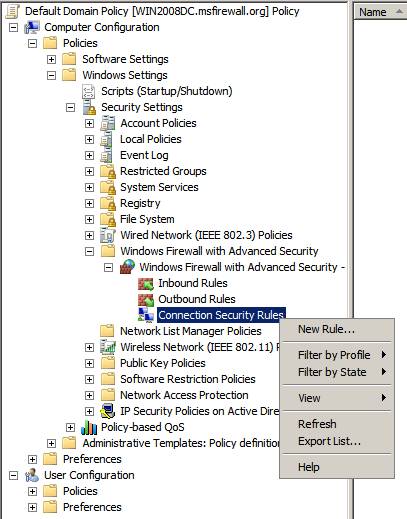
Figure 1
On the Rule Type page, select the Isolation option and click Next .
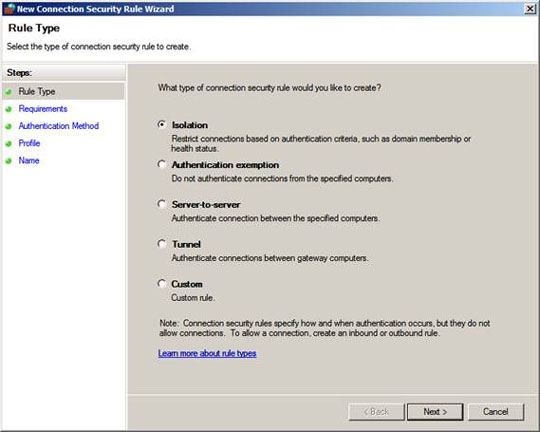
Figure 2
On the Authentication Method page, select Default and click Next .
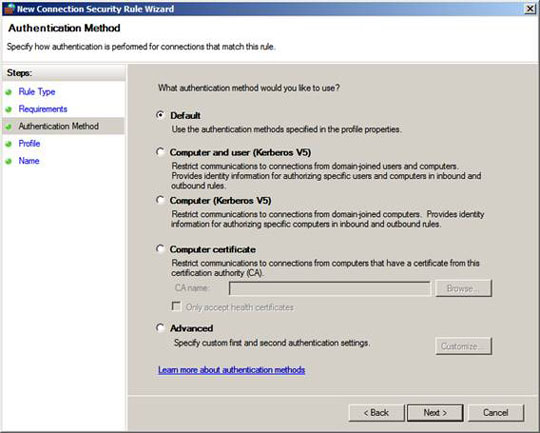
Figure 3
On the Name page, name the rule. In this example we set the Client / Server Domain Isolation and entered that instruction Encrypts and secure connections between all machines that are not DCs or infrastructure servers (DNS, DHCP, Default Gateway, WINS) .
Click Next .

Figure 4
Notice the rule in the list of connection security rules. You might wonder if we will encounter any problems here, because Client / Server Domain Isolation rule has all IP addresses, including the domain controller's IP addresses.
However, this does not matter because the rules are evaluated from the most specific to the least specific. Therefore, a more specific rule will be evaluated before a less specific rule. In the case of the two rules we have here, DC Request Security rule is more specific because Endpoint 2 is a specific IP address, while Client / Server Domain Isolation rule is Endpoint 2 any IP address.

Figure 5
Note that in a production environment we need to create some exception rules for certain devices that are exempt from authentication. DHCP, DNS, WINS and default gateway addresses need to be used by machines that are not domain members and thus cannot authenticate using Kerberos.
Create Firewall Rule to allow incoming Ping
To check the configuration, you can use the ping command to ping the server from a particular Vista client. To do this, it is necessary to allow ICMP pings to send requests to the test server. Create a rule that allows Vista clients to ping the server using Windows Firewall with Advanced Security MMC.
On the server, open Windows Firewall with Advanced Security from the Administrative Tools menu.
To the left of the console pane of Windows Firewall with Advanced Security, right-click the Inbound Rules button in the left pane and click New Rule .
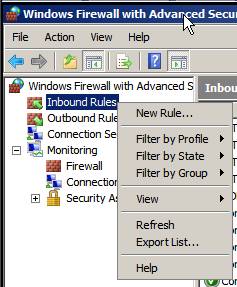
Figure 6
On the Rule Type page, select the Custom option and click Next .
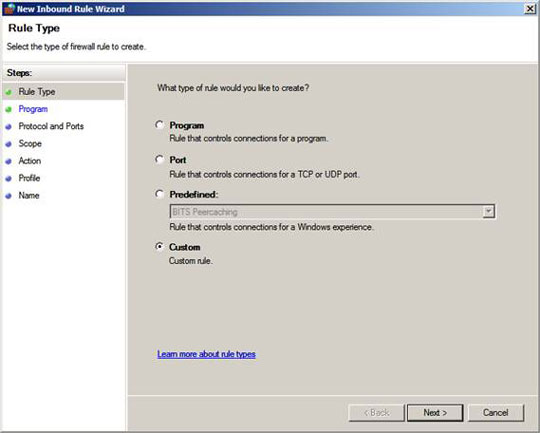
Figure 7
On the Program page, select the All Programs option and click Next .
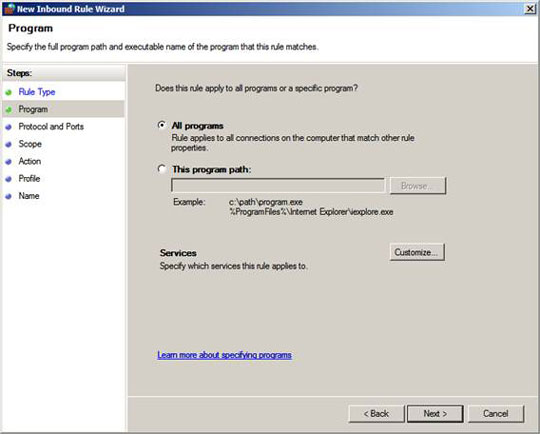
Figure 8
On the Protocol and Ports page, click the down arrow in the Protocol Type list and select the ICMPv4 option .
Click the Customize button. In the Customize ICMP Settings dialog box , select the Specific ICMP types option . Then check the Echo Request checkbox. Click OK .
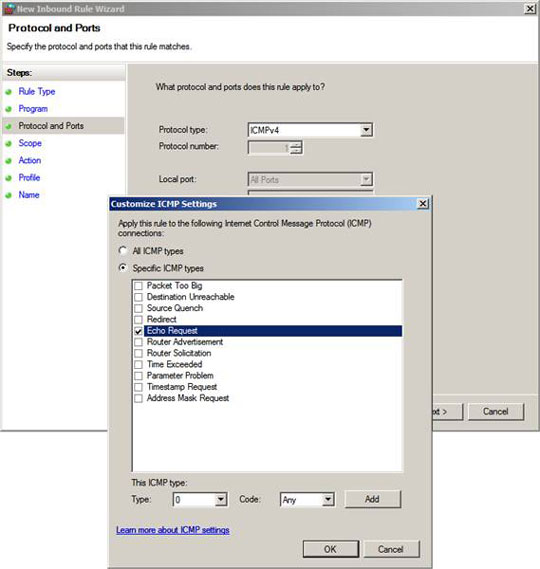
Figure 9
Click Next on the Protocol and Ports page .
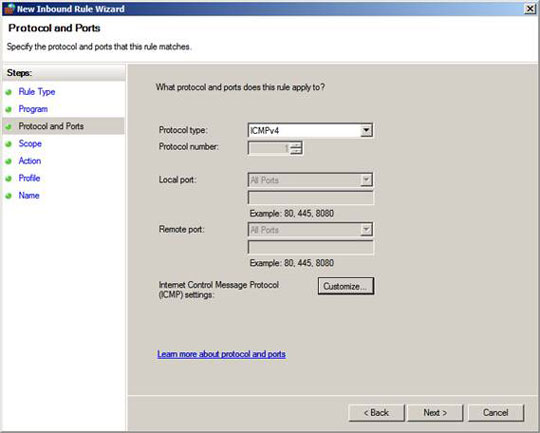
Figure 10
In the Scope dialog box, use the default settings for local and remote IP addresses , Any IP address. Click Next .

Figure 11
On the Action page, select the Allow the connection option and click Next .
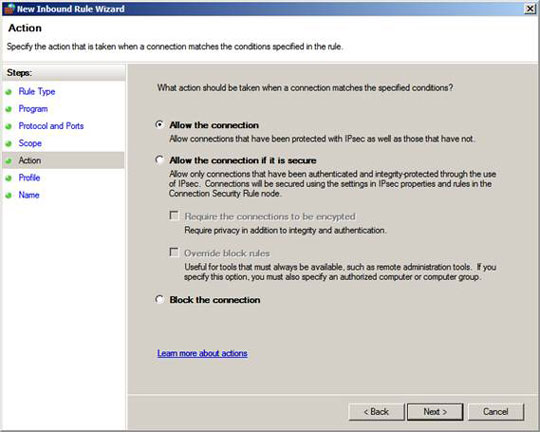
Figure 12
On the Profile page, remove the check marks from the Private and Public boxes and click Next .
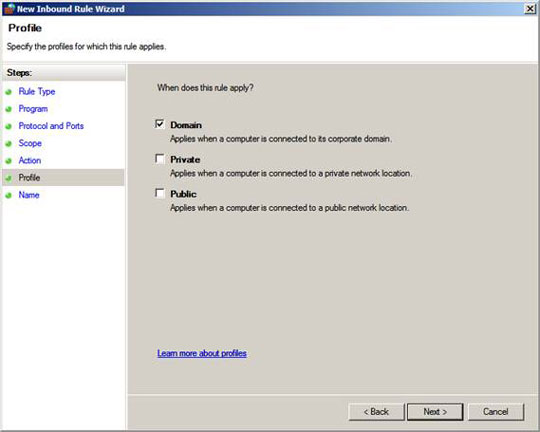
Figure 13
On the Name page, name the rule. In this example we name it Allow ICMP Request . Then click Finish .
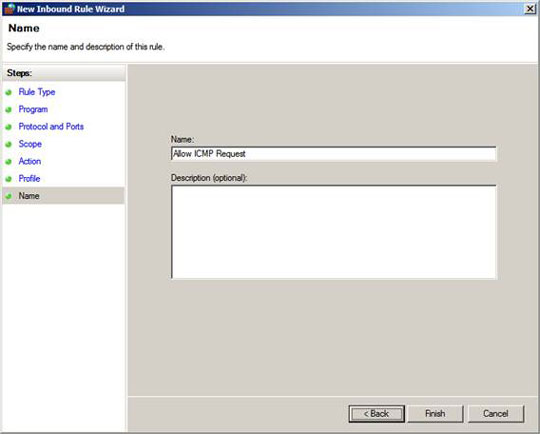
Figure 14
You can see Allow ICMP Request rule in the list of incoming rules.
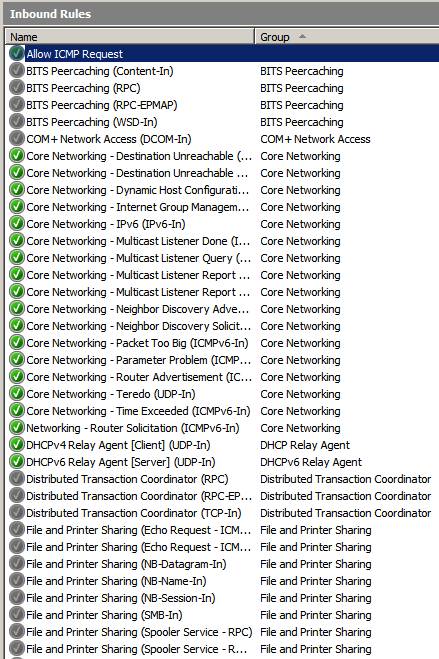
Figure 15
Observe the action of connection security
OK, now we're ready to see if things work! Go to the server and open the Windows Firewall with Advanced Security console, click the Connection Security Rules button in the left pane of the interface. You need to see the rules you created in Group Policy. If you do not see these rules, follow these instructions:
- At the domain controller, open a command prompt and type gpupdate / force , and then press ENTER to update Group Policy on the domain controller.
- After updating Group Policy on the domain controller, update Group Policy on the server by opening a command prompt and typing gpupdate / force , press ENTER to update Group Policy for the server.
- If still not working, try restarting the server and login again.
Then refresh the entire view of Connection Security Rules on the server to see an updated list of these rules. This is a similar list that you see in Group Policy Editor.

Figure 16
Click the Main Mode button in the left pane of the console. You must see that the server has established secure connections for both domain controllers and Vista clients. If you don't see secure connections to the Vista client, follow these instructions:
- Run gpupdate / force trene Vista client
- The Connection Security Rules configuration has been applied on Vista clients by checking them in the Windows Firewall with the Advanced Security MMC snap-in on this client.
- If you don't see the work, restart the client
- Ping to the Vista client from the server
After performing these steps, you need to see secure IPsec connections between the server and domain controller and the Vista client.

Figure 17
When you double click on one of the entries in the details pane of the Main Mode button, you can see the details of the secure connection.
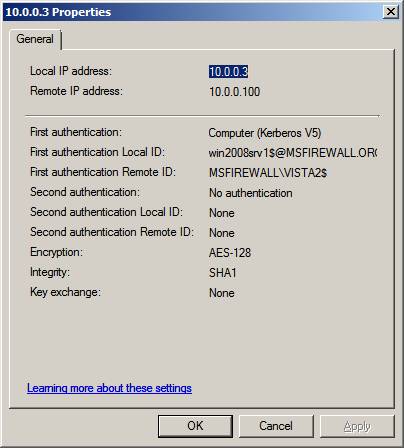
Figure 18
Click the Quick Mode button in the left panel of the console. You need to see secure connections for both domain controllers and Vista clients.

Figure 19
If you double click on one of the entries in the details pane of the Quick Mode button, you will see the details of the connection. Notice that ESP confidentiality is used and is using AES-128 bit encryption. This means that this connection is completely secure on the network and cannot be stolen by intruders.
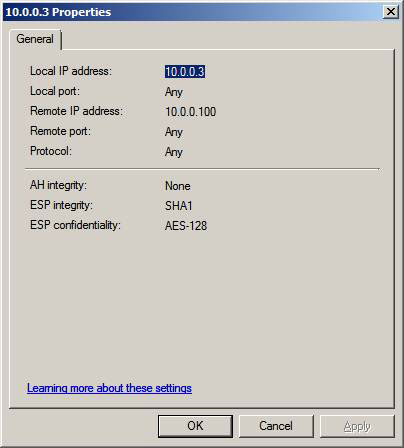
Figure 20
Conclude
In this article, I have shown you how to configure quarantine domain rules for servers and clients, and then configure the firewall on the server to allow incoming ping requests. Also in this article we checked to see if everything worked as expected by using the test features included in the Windows Firewall with Advanced Security console. This section also focuses on creating a simple quarantine domain policy to demonstrate how to configure isolated domain policies with the new tools available in Windows Server 2008 and Vista. More importantly, we demonstrate to you how to use Group Policy to focus on configuring domain isolation policy as a centralized management solution.
In the next part of this series we will demonstrate how to isolate the server. How useful is it when computers are not domain members? In that case we will show you how to use authentication methods to protect connections between computers that are not domain members.
You should read it
- Overview of Windows Server 2008 Firewall with advanced security features - Part 3
- Learn about firewalls, Windows Firewall on Windows Server 2012
- Configure advanced firewall in Windows 2008 using NETSH CLI
- Microsoft rushed to release security updates for Windows XP, Server 2003
- Overview of Windows Server 2008 Firewall with advanced security features - Part 2
- Application security with AppLocker
- Windows 7, Windows Server 2008 R2 will continue to be unofficially supported for another two years
- Creating SSL Server 2008 Server with ISA 2006 Firewalls (Part 1)
May be interested
- FTP security with Firewall ISA 2006 (Part 1)
 the isa firewall does not officially support the ftps protocol because the protocol agreements are encrypted and therefore no application filters can handle these agreements.
the isa firewall does not officially support the ftps protocol because the protocol agreements are encrypted and therefore no application filters can handle these agreements. - Top five desktop firewall software (continued)
 the online world is now dangerous, so which firewall should you use? today, independent firewall products are more and more exceptional than the original rule. we will look at 5 major firewalls, all of which can fit
the online world is now dangerous, so which firewall should you use? today, independent firewall products are more and more exceptional than the original rule. we will look at 5 major firewalls, all of which can fit - Check the TMG 2010 virtual private network server - Part 3: Configure TMG Firewall as L2TP / IPsec Remote Access VPN Server
 in part 3 of this series, i will show you how to configure tmg firewall as the l2tp / ipsec remote access vpn server.
in part 3 of this series, i will show you how to configure tmg firewall as the l2tp / ipsec remote access vpn server. - Overview of the TMG Firewall Troubleshooting feature
 one of the most recognizable enhancements in the tmg firewall is what is available in the isa 2006 firewall, which is the troubleshooting section.
one of the most recognizable enhancements in the tmg firewall is what is available in the isa 2006 firewall, which is the troubleshooting section. - Instructions to reset Windows Firewall Rules to the initial default state
 windows firewall is built into the windows operating system, which is an important part of the security system. however, over time, more and more applications are passed on the firewall. fortunately, however, you can reset windows firewall to its original default settings.
windows firewall is built into the windows operating system, which is an important part of the security system. however, over time, more and more applications are passed on the firewall. fortunately, however, you can reset windows firewall to its original default settings. - What is a firewall? General knowledge about Firewall
 what is a firewall or what is a firewall? how does the firewall work? is it safe to use only the built-in firewall? you will get answers to all the firewall issues in this article.
what is a firewall or what is a firewall? how does the firewall work? is it safe to use only the built-in firewall? you will get answers to all the firewall issues in this article. - Install and configure email handling solutions on TMG 2010 Firewall - Part 3
 in this section, i will show you what you can do when configuring the anti-spam features on the tmg 2010 firewall.
in this section, i will show you what you can do when configuring the anti-spam features on the tmg 2010 firewall. - Install and configure email handling solutions on TMG 2010 Firewall - Part 4
 in part 4 of this series, i will show you the virus and content filtering features on tmg 2010 firewall.
in part 4 of this series, i will show you the virus and content filtering features on tmg 2010 firewall. - Detecting and preventing intrusion in Forefront TMG - Part 2: NIS
 in part 2 of this series, we will introduce the tmg firewall's advanced intrusion detection and prevention features.
in part 2 of this series, we will introduce the tmg firewall's advanced intrusion detection and prevention features. - ZoneAlarm Free Firewall 158_181_18901, download ZoneAlarm Free Firewall here
 zonealarm free firewall is software that provides advanced layers of protection to monitor and block unwanted traffic, protect personal data, and prevent hackers and malware from performing bad behavior with the system. .
zonealarm free firewall is software that provides advanced layers of protection to monitor and block unwanted traffic, protect personal data, and prevent hackers and malware from performing bad behavior with the system. .










 Protect your business against internal threats
Protect your business against internal threats Automatic patch management applications
Automatic patch management applications Techniques for decentralizing Window administration
Techniques for decentralizing Window administration Keep the router configuration safe
Keep the router configuration safe 10 security threats on virtual servers
10 security threats on virtual servers Multi-factor authentication in Windows - Part 1: USB tokens and smart cards
Multi-factor authentication in Windows - Part 1: USB tokens and smart cards